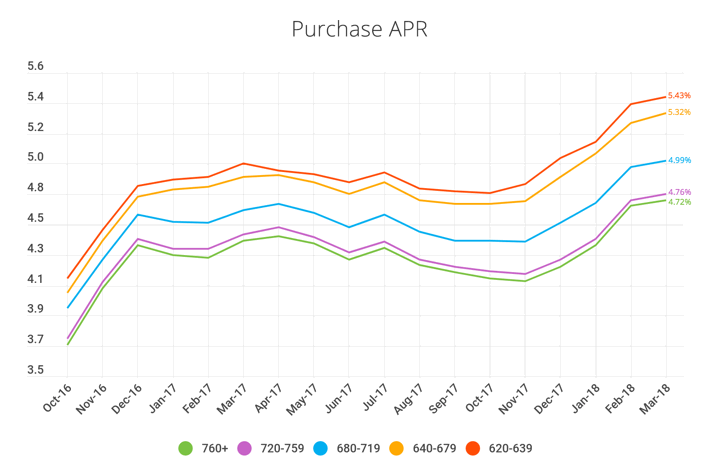Mortgage rates are rising. Home prices are still at recent highs. Yet, mortgage applications are also up, which suggests that people are worried about not being able to afford a house if they wait. Online mortgage comparison site LendingTree publishes a monthly update (March 2018) of what their real customers are getting approved for on their mortgages. Credit score, average APR, down payment, loan-to-value ratio, etc. Here is a chart of mortgage rates vs. credit score.

Clean up your credit score. The survey suggests that the rate difference between the top credit scores and lower scores are widening:
Consumers with the highest credit scores (760+) saw offered APRs of 4.72% in March, vs 4.99% for consumers with scores of 680-719. The APR spread of 27 bps between these score ranges was unchanged from February and still near the widest since this data series began in April 2016. The spread represents over $14,000 in additional costs for borrowers with lower credit scores over 30 years for the average purchase loan amount of $238,593.
I recently paid my income taxes with a credit card, netting some profit but also using up over 50% of the total credit limit. My credit score monitoring services told me this increased debt utilization lowered my credit score by 40 points! This is exactly the type of thing you shouldn’t do if you are in the market for a new mortgage or refinance. If anything, I should have paid off the balance immediately before it was reported to the credit bureaus.
 The Best Credit Card Bonus Offers – 2025
The Best Credit Card Bonus Offers – 2025 Big List of Free Stocks from Brokerage Apps
Big List of Free Stocks from Brokerage Apps Best Interest Rates on Cash - 2025
Best Interest Rates on Cash - 2025 Free Credit Scores x 3 + Free Credit Monitoring
Free Credit Scores x 3 + Free Credit Monitoring Best No Fee 0% APR Balance Transfer Offers
Best No Fee 0% APR Balance Transfer Offers Little-Known Cellular Data Plans That Can Save Big Money
Little-Known Cellular Data Plans That Can Save Big Money How To Haggle Your Cable or Direct TV Bill
How To Haggle Your Cable or Direct TV Bill Big List of Free Consumer Data Reports (Credit, Rent, Work)
Big List of Free Consumer Data Reports (Credit, Rent, Work)
Mint tells me not to use more than 30% of my credit cards limit or it will decrease my credit score.
Thanks, 30% is probably a good number to stay under. I don’t know if there are hard boundaries, but I’ve also heard 50% and 90% are important numbers where your credit score drops. This is why higher credit limits can be helpful, even if you never plan on using them fully.
In regards to your reported credit card utilization ratio as seen on your credit report, one way you can control the amount reported to the credit agencies is to pay down your balance just before they report debt amounts. You can do this by observing the average date of the month that each bank reports to the credit agency, and then paying down the balance to whatever amount you would like to be reported. That way, paying large amounts like property taxes, medical bills, home improvement costs, etc can still be used to garner profit while not dropping your credit score. I have used this method for 5+ years now, and it was ecspecially useful around the time I was preparing to apply for a mortgage to make sure I had my credit score in the highest rate possible.